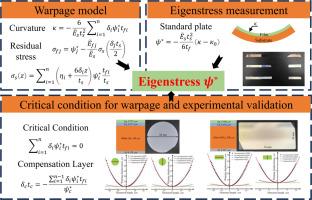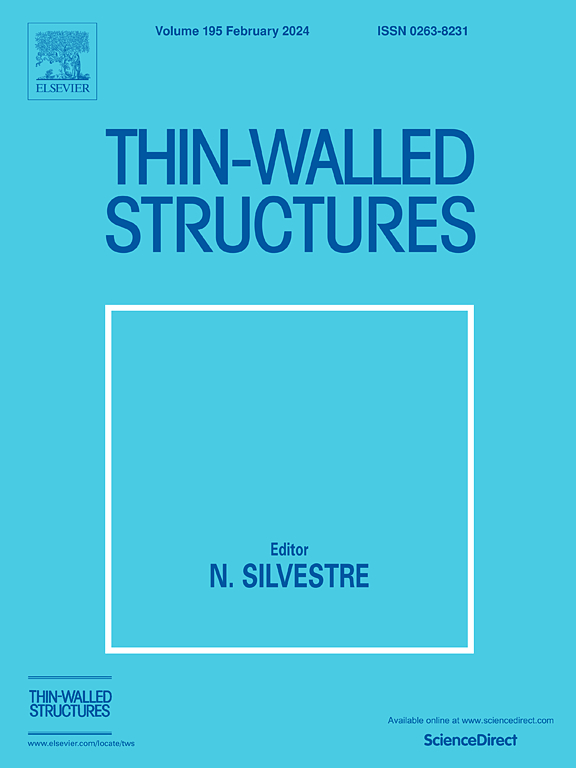使用特征应变法对多层薄膜/基底系统进行翘曲分析
IF 5.7
1区 工程技术
Q1 ENGINEERING, CIVIL
引用次数: 0
摘要
薄膜沉积在基底上产生的翘曲仍然是一个长期存在的难题,严重影响了众多先进设备的应用。为了精确评估多层薄膜/基底系统的翘曲,我们在翘曲分析中采用了特征应变法。基于经典层压理论,我们建立了一个分析模型来预测多层薄膜/基底系统中的翘曲和残余应力。我们引入了一个称为 "特征应力 "的新概念,作为翘曲的根本原因,并描述了制造过程对翘曲的影响。理论分析和模拟证明,翘曲完全由特征应力和其他与工艺无关的参数决定。该模型还解释了沉积在同一基底上的薄膜之间几乎不存在相互作用。研究了使用标准板测量特征应力的实验方法。测得的特征应力与相应的热应力差别很大。我们还提出了多层薄膜/基底系统翘曲的临界条件及其控制方程。实验结果证实,在翘曲基板上添加补偿层可大大减少翘曲。基于 "特征应力 "的翘曲模型为准确预测和控制多层薄膜/基底系统的翘曲提供了理论基础。本文章由计算机程序翻译,如有差异,请以英文原文为准。

Warpage analysis of multilayer thin film/substrate systems using the Eigenstrain method
Warpage resulting from the deposition of films on substrates remains a persistent challenge that significantly impacts the application of numerous advanced devices. To precisely evaluate warpage in multilayer thin film/substrate systems, we employ the eigenstrain method in the warpage analysis. An analytical model is developed to predict warpage and residual stress in multilayer film/substrate system based on classical laminate theory. We introduce a novel concept termed “Eigenstress”, which serves as the fundamental cause of warpage and characterizes the influence of the manufacturing process on warpage. Theoretical analysis and simulation demonstrate that warpage is entirely determined by eigenstress and other process-independent parameters. This model also explains that there is little interaction between thin films deposited on the same substrate. An experimental method is studied for measuring eigenstress using a standard plate. The measured eigenstress differs significantly from the corresponding thermal stress. We also propose a critical condition and its governing equation for warpage in multilayer film/substrate systems. Experimental results confirm that adding a compensation layer on a warped substrate can considerably reduce warpage. The warpage model based on “Eigenstress” provides a theoretical foundation for accurately predicting and controlling warpage in multilayer thin film/substrate systems.
求助全文
通过发布文献求助,成功后即可免费获取论文全文。
去求助
来源期刊

Thin-Walled Structures
工程技术-工程:土木
CiteScore
9.60
自引率
20.30%
发文量
801
审稿时长
66 days
期刊介绍:
Thin-walled structures comprises an important and growing proportion of engineering construction with areas of application becoming increasingly diverse, ranging from aircraft, bridges, ships and oil rigs to storage vessels, industrial buildings and warehouses.
Many factors, including cost and weight economy, new materials and processes and the growth of powerful methods of analysis have contributed to this growth, and led to the need for a journal which concentrates specifically on structures in which problems arise due to the thinness of the walls. This field includes cold– formed sections, plate and shell structures, reinforced plastics structures and aluminium structures, and is of importance in many branches of engineering.
The primary criterion for consideration of papers in Thin–Walled Structures is that they must be concerned with thin–walled structures or the basic problems inherent in thin–walled structures. Provided this criterion is satisfied no restriction is placed on the type of construction, material or field of application. Papers on theory, experiment, design, etc., are published and it is expected that many papers will contain aspects of all three.
 求助内容:
求助内容: 应助结果提醒方式:
应助结果提醒方式:


